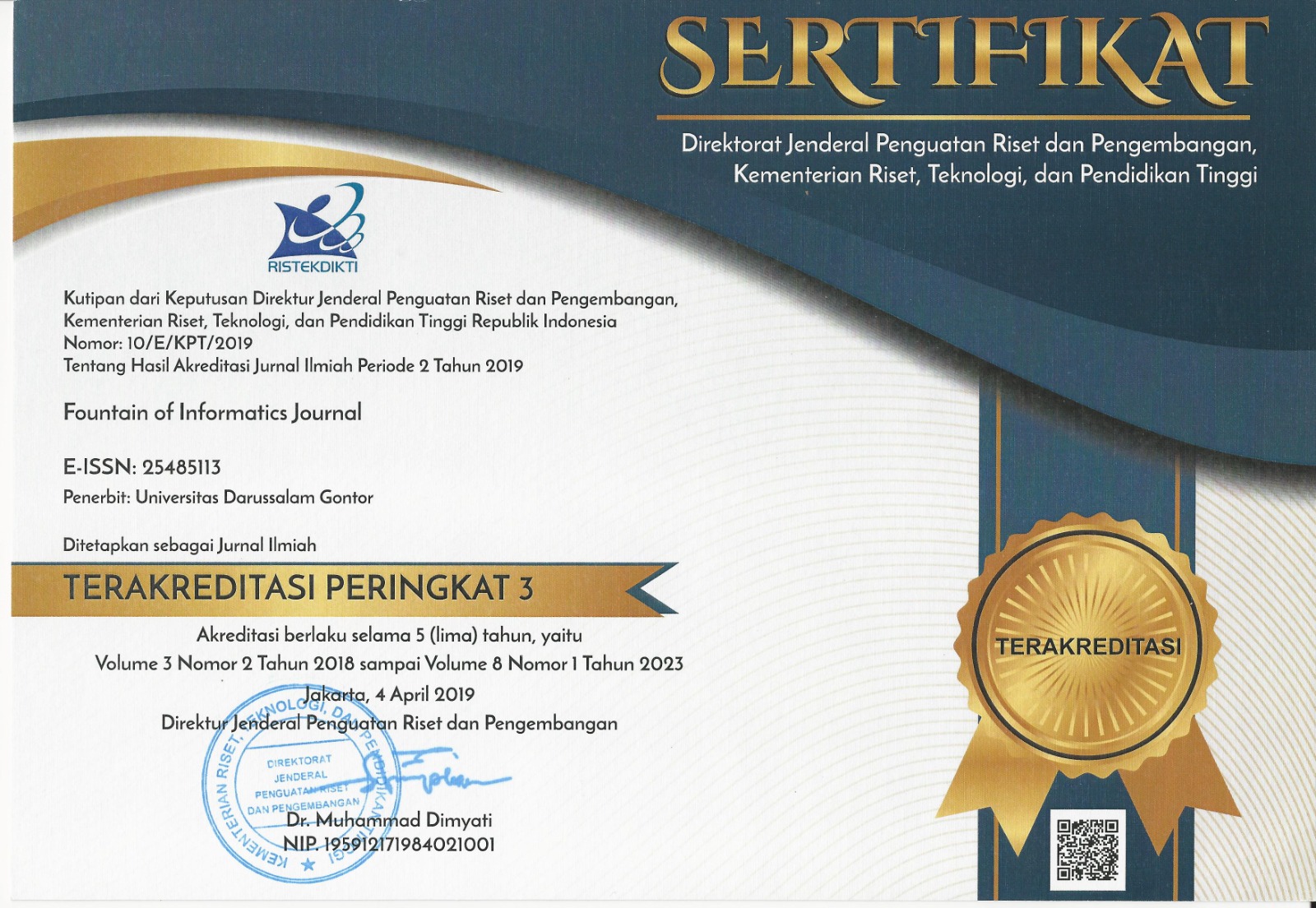Analisa Hasil Rekomendasi Pembimbing Menggunakan Multi-Attribute Dengan Metode Weighted Product
DOI:
https://doi.org/10.21111/fij.v2i1.912Keywords:
field work practice, evaluation, Weighted ProductAbstract
The development world of work is influenced by several factors such as the performance of human resources, so that each company tried to get quality employees. Improvement of human resources can be obtained from the process of field work practice in college. The field supervisor is a quality improvement factor for the students. Generally the selection of lecturers of fieldwork practice practicum is done without recommendation from students. That condition make students facing problems in field work practice. One of them is the students have difficulty adjusting to the supervisor because the characteristics of lecturers obtained from the college does not match with the required students. Therefore, a recommendation system of guidance lecturers in the field of Information System Department of X University facilitates the students to recommend lecturers according to their needs. In the recommendation process of lecturers the field work practices is conducted with the assessment of five variables. Variables obtained from lecturer performance assessment. Each of these assessments is taken into account and considered according to the needs of the students in the field. That system is made using decision support system method by multi-attribute of Weighted Product. Resulted of the analysis that has been done obtained an alternative of lecturers selected from the group of fieldwork students and the evaluation of lecturer selection by the student group. The result of the method is known that the analysis can give the recommendation of the supervisor lecturers to the student group in accordance with the highest score.References
http://citec.amikom.ac.id/main/index.php/citec/article/view/49">[1] Saleh, A. (2015). Implementasi Metode Klasifikasi Naïve Bayes dalam Memprediksi Besarnya Penggunaan Listrik Rumah Tangga. Citec Journal, 2(3), 207–217.[2] Sucipto, S., Kusrini, K., & Taufiq, E. L. (2016). Classification method of multi-class on C4.5 algorithm for fish diseases. In 2016 2nd International Conference on Science in Information Technology, ICSITech 2016: Information Science for Green Society and Environment (pp. 5–9).[3] Kalbande, D., & Thampi, G. (2009). Multi-attribute and Multi-criteria Decision Making Model for technology selection using fuzzy logic. TECHNIA International Journal of Computing Science and Communication Technologies, 2(1), 377–383.[4] Sharma, M. (2013). Multi Attribute Decision Making Techniques. International Journal of Research in Management, Science & Technology, 1(1), 49–51.[5] Uyun, S., & Riadi, I. (2011). A Fuzzy Topsis Multiple-Attribute Decision Making for Scholarship Selection. Telkomnika, 9(1), 37–46.[6] Adriyendi, A. (2015). Multi-Attribute Decision Making Using Simple Additive Weighting and Weighted Product in Food Choice. International Journal of Information Engineering and Electronic Business, 7(6), 8–14.[7] Kusrini. (2007). Konsep dan Aplikasi Sistem Pendukung Keputusan. Yogyakarta:Andi.[8] Kusumadewi. (2006). Fuzzy Multi Attribute Decision Making (Fuzzy MADM). Yogyakarta: Graha Ilmu.
Downloads
Submitted
Accepted
Published
Issue
Section
License
Please find the rights and licenses in the Fountain of Informatics Journal (FIJ). By submitting the article/manuscript of the article, the author(s) agree with this policy. No specific document sign-off is required.
1. License
The non-commercial use of the article will be governed by the Creative Commons Attribution license as currently displayed on Creative Commons Attribution-NonCommercial-ShareAlike 4.0 International License.
2. Author(s)' Warranties
The author warrants that the article is original, written by the stated author(s), has not been published before, contains no unlawful statements, does not infringe the rights of others, is subject to copyright that is vested exclusively in the author, and free of any third party rights, and that any necessary written permissions to quote from other sources have been obtained by the author(s).
3. User/Public Rights
FIJ's spirit is to disseminate articles published are as free as possible. Under the Creative Commons license, FIJ permits users to copy, distribute, display, and perform the work for non-commercial purposes only. Users will also need to attribute authors and FIJ on distributing works in the journal and other media of publications. Unless otherwise stated, the authors are public entities as soon as their articles got published.
4. Rights of Authors
Authors retain all their rights to the published works, such as (but not limited to) the following rights;
- Copyright and other proprietary rights relating to the article, such as patent rights,
- The right to use the substance of the article in own future works, including lectures and books,
- The right to reproduce the article for own purposes,
- The right to self-archive the article (please read out deposit policy),
- The right to enter into separate, additional contractual arrangements for the non-exclusive distribution of the article's published version (e.g., post it to an institutional repository or publish it in a book), with an acknowledgment of its initial publication in this journal (Jurnal Optimasi Sistem Industri).
5. Co-Authorship
If the article was jointly prepared by more than one author, any authors submitting the manuscript warrants that he/she has been authorized by all co-authors to be agreed on this copyright and license notice (agreement) on their behalf, and agrees to inform his/her co-authors of the terms of this policy. FIJ will not be held liable for anything that may arise due to the author(s) internal dispute. FIJ will only communicate with the corresponding author.
6. Royalties
Being an open accessed journal and disseminating articles for free under the Creative Commons license term mentioned, author(s) aware that FIJ entitles the author(s) to no royalties or other fees.
7. Miscellaneous
FIJ will publish the article (or have it published) in the journal if the article’s editorial process is successfully completed. FIJ's editors may modify the article to a style of punctuation, spelling, capitalization, referencing, and usage that deems appropriate. The author acknowledges that the article may be published so that it will be publicly accessible and such access will be free of charge for the readers as mentioned in point 3.











